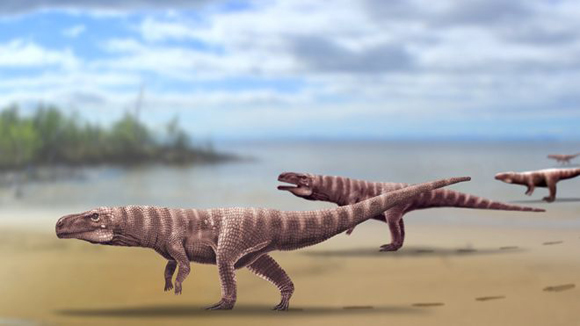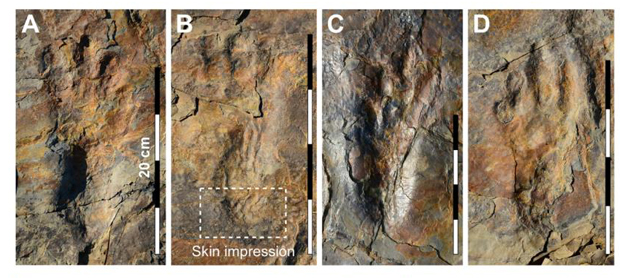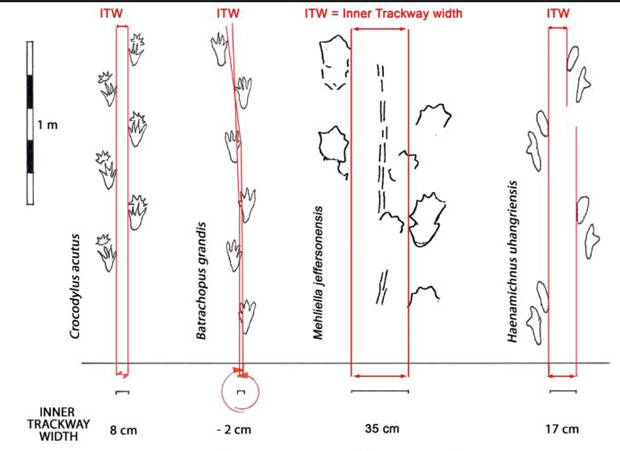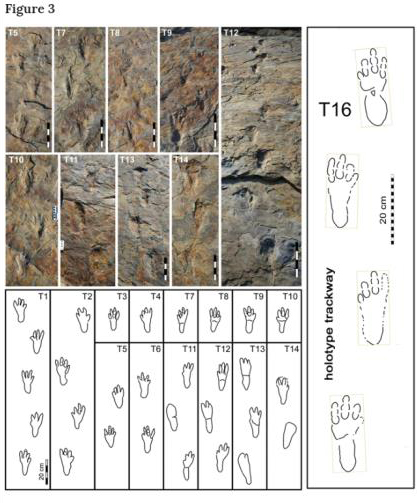Fossil Tracks Attributed to Crocodiles Show Bipedal Stance
Fossilised narrow-gauge tracks from the Lower Cretaceous Jinju Formation of South Korea suggest that some types of ancient crocodylomorphs were bipedal. Writing in the academic journal “Scientific Reports”, the researchers which include palaeontologist Martin Lockley, an emeritus professor at the University of Colorado, describe a series of trackways discovered near Sacheon City, (south-eastern, South Korea). Only prints made by the hind limbs are preserved and there are no manus (handprints) identified. The quality of the trace fossils, the presence of well-preserved foot pads with skin traces and the absence of any foot-on-hand overprinting suggest that these ancient reptiles walked on their hind legs.
Studying Ancient Crocodiles
The tracks have been assigned to the ichnogenus Batrachopus and the largest tracks are believed to have been made by animals around three metres long.
A Life Reconstruction of the Ichnogenus Batrachopus (B. grandis)

Picture credit: A. Romilio (University of Queensland)
Batrachopus grandis
The tracksite covers approximately 800 square metres and has yielded four track-bearing levels from a series of strata the represent about 5 metres of the Jinju Formation. The deposits consist of mudstones, shales and fine-grained sandstones that represent the margins of a large freshwater lake. Based on the size of the prints, some of which measure up to 24 cm in length, the researchers have erected the ichnospecies Batrachopus grandis. One track shows well-defined scale impressions on the heel that resemble those of modern crocodilians.
Tracks of the Ichnospecies Batrachopus grandis with Skin Impression Preserved (Photograph B).

Picture credit: Kim et al
An Upright Bipedal Posture
The absence of any tail drag marks and the depth of the heel impressions support the idea that these reptiles were moving in a similar way to most theropod dinosaurs. Team leader, Professor Kyung Soo Kim (Chinju National University of Education, South Korea), also stated that the width of the tracks indicate that these crocodiles were walking upright in a terrestrial environment.
The Professor remarked:
“Our trackways are very narrow-looking, more like a crocodile balancing on a tight-rope. When combined with the lack of any tail-drag marks, it became clear that these creatures were moving bipedally. They were moving in the same way as many dinosaurs, but the footprints were not made by dinosaurs. Dinosaurs and their bird descendants walk on their toes.”
Plantigrade Prints
The Dinosauria generally, non-avian and avian forms, walk on their toes (digitigrade), whilst crocodiles walk on the soles of their feet, just like humans and bears (plantigrade). The plantigrade nature of the tracks rules out them having been made by a member of the Dinosauria clade.
Photographs and Line Drawings of Trackways (Batrachopus grandis)
Picture credit: Kim et al
The picture above shows photographs and line drawings of trackways and trackway segments associated with the ichnospecies B. grandis. The holotype track (T16), is enlarged and shown as a line drawing on the right.
These Tracks Shed Light on Pterosaur Locomotion
These tracks may also help to determine the track-maker from another tracksite from South Korea that was described back in 2012. Professor Lockley was part of a research team that uncovered a set of less-well defined prints that were thought to have been made by a huge pterosaur. It had been suggested that these tracks represented a flying reptile wading through shallow water with just its hind feet in contact with the sediment. Although these tracks are geologically younger than the trackways discovered near Sacheon City, Professor Lockley discounts the wading pterosaur theory and suggests that these tracks too, were probably made by a bipedal crocodylomorph.
The Scientists Compared the Tracks to Other Tracks from the Fossil Record and with Those Made by American Crocodiles

Picture credit: Kim et al
The picture above, shows (far left) the trackway created by an extant crocodile species, the American crocodile (C. acutus). A line drawing of a track associated with B. grandis is adjacent. Note that the B. grandis tracks are narrower. The third track represents a crocodilian known from trace fossils from Colorado (Mehliella jeffersonensis). These tracks indicate quadruped locomotion and a clear tail drag mark is preserved in the centre of the trackway. The line drawing (far right), represents tracks that had been thought to represent a pterosaur trackway (Haenamichnus uhangriensis).
Haenamichnus uhangriensis
The flying reptile tracks come from the Lower Cretaceous Haman Formation located in South Korea. The large, bipedal plantigrade prints were assigned the ichnospecies Haenamichnus uhangriensis and it had been proposed that the tracks represented a pterosaur wading through shallow water, trying to avoid its wings becoming mired in the substrate. The researchers confidently conclude that these tracks do not represent a large flying reptile and that they are actually poorly preserved bipedal crocodylomorph trace fossils.
To read a related article about the discovery of tiny dinosaur tracks: Smallest Dinosaur Tracks Known to Science.
The scientific paper: “Trackway evidence for large bipedal crocodylomorphs from the Cretaceous of Korea” by Kyung Soo Kim, Martin G. Lockley, Jong Deock Lim, Seul Mi Bae & Anthony Romilio published in Scientific Reports.
The Everything Dinosaur website: Everything Dinosaur.







Leave A Comment